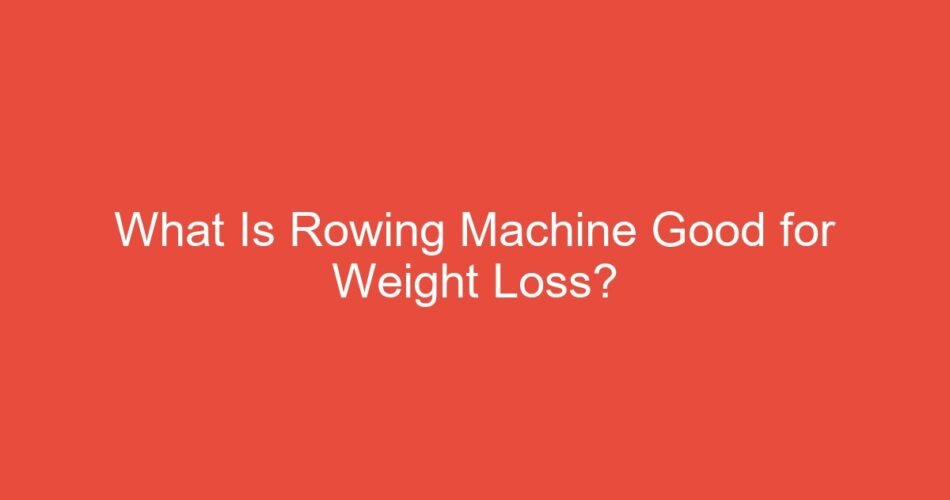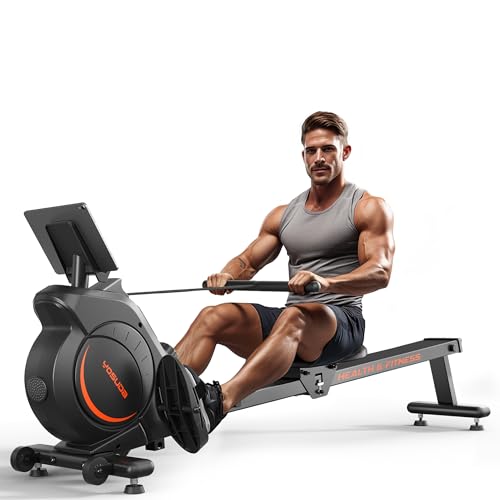The rowing machine stands out among gym equipment for delivering a powerful, low-impact workout that targets nearly 86% of the body’s musculature, making it a highly efficient tool for shedding pounds.
The rowing machine is exceptionally good for weight loss because it offers a highly efficient, full-body, high-intensity cardiovascular workout that maximizes calorie expenditure and builds metabolism-boosting lean muscle mass. To truly understand what is rowing machine good for weight loss the key lies in its unique combination of strength training and continuous aerobic exercise, commonly referred to as an ergometer.
The Science of Calorie Burning: Why Rowing Works
Rowing machines (or “ergs”) facilitate rapid and sustained weight loss primarily because they engage the largest muscle groups in the body simultaneously. When muscles work harder, they demand more oxygen, forcing the heart to pump faster and elevate the metabolic rate.
🛒 Recommended Product
This high muscle recruitment translates directly into superior calorie burning. According to data compiled by Harvard Health Publishing, rowing burns calories at a rate comparable to or exceeding running, but without the high impact on the joints.
Here is a quick comparison of approximate calorie burn for 30 minutes of vigorous effort:
| Body Weight | Running (6 mph/10 min mile) | Rowing Machine (Vigorous) |
|---|---|---|
| 125 lbs | 300 calories | 255 calories |
| 155 lbs | 372 calories | 316 calories |
| 185 lbs | 444 calories | 377 calories |
| 200 lbs | 480 calories | 408 calories |
Because the rowing stroke requires sustained power output against resistance, the body spends calories not just on movement, but also on rebuilding muscle fiber, keeping the metabolic furnace hot long after the workout is complete.
Rowing Machine Weight Loss: Full-Body Muscle Activation
Unlike cycling or running, which primarily isolate the lower body, rowing is a genuine full-body movement that strategically distributes the workload, preventing early muscle fatigue and allowing users to sustain high intensity longer.
Rowing engages nearly 86% of the major muscles across the four phases of the stroke:
- The Drive (60% Lower Body): This is the power phase, where the legs push off the foot stretcher. Quadriceps, hamstrings, and glutes are heavily utilized. This is the source of the majority of your power.
- The Catch and Finish (30% Core and Back): The core (abdominals and lower back) stabilizes the trunk throughout the movement, preventing injury and transferring power from the lower to the upper body. The upper back and latissimus dorsi (lats) initiate the backward lean.
- The Pull (10% Upper Body): The arms and shoulders finish the stroke by pulling the handle towards the sternum. Biceps, triceps, and deltoids are engaged last.
This integrated movement pattern forces energy expenditure across the entire body, significantly raising the heart rate and making the rowing machine an ideal method for simultaneous fat loss and muscle toning.
🛒 Recommended Product
Optimizing Your Ergo for Maximum Fat Loss
To leverage what is rowing machine good for weight loss requires varying your workout intensity. While a steady, consistent pace (Steady State Cardio) is excellent for cardiovascular endurance and burning fat during the session, incorporating High-Intensity Interval Training (HIIT) yields the best long-term results.
1. High-Intensity Interval Training (HIIT)
HIIT rowing involves alternating between short bursts of maximum effort (sprints) and brief periods of active recovery. This training method is highly effective for weight loss because it triggers the “afterburn effect,” scientifically known as Excess Post-exercise Oxygen Consumption (EPOC).
During EPOC, the body continues to burn calories at an elevated rate for hours after the workout is finished as it restores oxygen levels and repairs muscle tissue. A typical HIIT rowing protocol might include:
- 5 minutes warm-up (low intensity).
- 8 rounds of 1 minute maximum sprint followed by 1 minute light recovery rowing.
- 5 minutes cool-down.
2. Monitoring Performance Metrics
Focusing on key metrics can significantly boost weight loss efforts:
- Split Time: This is the time it takes to row 500 meters. A lower split time indicates higher power output and speed. For serious weight loss, aim to consistently lower your average split time over time.
- Strokes Per Minute (SPM): This indicates rhythm and intensity. Weight loss rowing generally falls into two zones: Endurance (20-25 SPM) and HIIT/Power (28-35+ SPM).
Understanding Resistance and Damper Settings
Many beginners mistakenly believe that setting the damper (the lever on the side of the flywheel) to 10 will yield a harder, more calorie-intensive workout. In reality, the damper setting controls the feel of the row, mimicking the drag of a small, fast boat (low setting) or a large, heavy boat (high setting).
For maximum weight loss and efficient rowing, the force of the pull should primarily come from the legs, not the arms.
🛒 Recommended Product
- Ideal Damper Setting: Most rowers benefit from a setting between 3 and 5. This range provides a feel similar to rowing on water and allows the user to maintain the correct, fluid form needed to maximize muscle recruitment and minimize the risk of back injury.
- Focus on Power, Not Resistance: Your true resistance comes from how hard you drive with your legs. A setting of 3 combined with a powerful leg drive is far more challenging and effective for weight loss than an effortless pull at a setting of 10.
Conclusion
The rowing machine is an outstanding investment for those prioritizing weight loss and total fitness. Because it provides a unique combination of high-intensity cardio and low-impact resistance training, the ergometer allows individuals to burn high amounts of calories and dramatically increase their metabolic rate. By utilizing proper form and incorporating HIIT principles, the effectiveness of the rowing machine for weight loss makes it one of the most powerful tools in any fitness arsenal.
Scientific References & Research
The following peer-reviewed research papers provide additional scientific context:
-
GE Chapman (1997).
Making weight: Lightweight rowing, technologies of power, and technologies of the self
[External Link] -
A Ledvinkova (n.d.).
[HTML] Exercise Bike vs Rowing Machine: Which is Better for Weight Loss?
[External Link] -
SR Kang et al. (2014).
Comparative analysis of basal physical fitness and muscle function in relation to muscle balance pattern using rowing machines
[External Link]
Note: External research links are provided for educational purposes and do not necessarily represent endorsement.
Frequently Asked Questions About What Is Rowing Machine Good for Weight Loss?
Q. Does rowing specifically target fat or does it only burn overall calories?
A. Rowing burns overall calories by utilizing both aerobic and anaerobic systems, and since weight loss fundamentally requires burning more calories than consumed, this leads to fat loss over time. As a high-intensity, low-impact exercise, it effectively elevates the heart rate into the fat-burning zones while preserving muscle mass, which is crucial because maintaining muscle increases resting metabolic rate. Consistent rowing, combined with proper nutrition, forces the body to utilize stored fat for energy.
Q. How important is proper form on the rowing machine for maximizing weight loss benefits and preventing injury?
A. Proper form is paramount for maximizing calorie burn because it ensures that the powerful leg drive (the ‘catch’) is efficiently transferred through the core and arms, engaging the largest muscle groups for maximum energy expenditure. Incorrect form, particularly slumping or relying too heavily on the arms, significantly reduces caloric output and raises the risk of back or joint injury, leading to inconsistent training and hindering weight loss progress. Focusing on the powerful sequence—legs, core, arms—is essential for both safety and effectiveness.
Q. Beyond just cardio, what role does the rowing machine play in building muscle mass, which aids long-term weight management?
A. The rowing machine is a unique blend of cardiovascular and resistance training; while primarily cardio, the resistance involved in the drive phase helps to build and tone muscle across the legs, glutes, core, back, and arms. This increased muscle mass is vital for long-term weight management because muscle tissue is metabolically active, meaning it burns more calories at rest than fat tissue does. Regular rowing helps improve body composition by decreasing fat percentage while increasing lean mass.
Qt. Should beginners focus on long, steady-state rowing or shorter, high-intensity interval training (HIIT) to kickstart weight loss?
A. Beginners should initially focus on steady-state rowing to establish proper form, build endurance, and create a foundational caloric deficit without risking burnout or injury. Once consistency and form are achieved, incorporating shorter, high-intensity interval training (HIIT) sessions becomes highly effective for accelerating weight loss due to the enhanced calorie burn during the workout and the substantial afterburn effect (EPOC). A combination of both steady-state for volume and HIIT for intensity provides the most balanced and effective approach.
Q. How often and for how long should someone row weekly to see noticeable weight loss results?
A. To see noticeable weight loss results, individuals should aim for consistency, generally rowing 3 to 5 times per week, with sessions ranging from 20 to 45 minutes depending on the intensity level chosen. The total weekly time commitment should aim for at least 150 minutes of moderate-intensity or 75 minutes of vigorous-intensity rowing to meet basic health guidelines and create the necessary weekly energy expenditure for sustained weight reduction. Results become most visible when rowing is paired with a strategic reduction in overall caloric intake.
Related Articles
Do Weight Loss Vibration Machines Work?
Vibration machines alone are not magic diet tools Do Weight Loss Vibration Machines Work The consensus from clinical trials suggests they are effectiv…
Do Rowing Machines Help with Weight Loss?
Do Rowing Machines Help with Weight Loss? Rowing machines are an outstanding tool for significant weight loss, uniquely combining high-intensity cardi…
Do Elliptical Machines Work for Weight Loss?
Ellipticals offer a powerful, low-impact solution for achieving aggressive weight management goals. Find out exactly how many calories you can burn an…
When you purchase a product through Amazon links on EllipticalKing.com, we may earn a small commission at no extra cost to you. This helps support the site and keep our content free.




